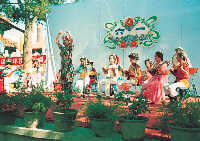| |
Rescue and Protection of Xinjiang Traditional Arts
( 2005-09-13 )
 Children's Arts and Culture Children's Arts and Culture
 In Xinjiang, children's arts and culture are enjoying steady, healthy, and vigorous development under the support of all levels of governments. In Xinjiang, children's arts and culture are enjoying steady, healthy, and vigorous development under the support of all levels of governments.
By 2002, Xinjiang had established about 20 children's art troupes (provincial, municipal, and city levels), 10 children's choruses, five children's schools of fine arts, and three children's schools for instrumental music. At the same time, a lot of training programs in various branches of art have been designed for children, including such arts as TV and film, program hosting, and theater acting.
Many talented children have been discovered and given opportunities to develop their potential, many outstanding children's artistic productions have been staged, and the frequent and vibrant arts and cultural events held by and for the children are reflecting an ever-opening and rejuvenated Xinjiang.
The "Little Poplar Tree," a Xinjiang children's art troupe established in 1987, is an exemplary art group administered by the Xinjiang Children's Arts and Culture Council. Apart from being an active participant of major artistic events organized by the autonomous region, the Little Poplar Tree has frequently toured places like Japan, Singapore, Germany, Kazakhstan, and China'sTaiwanProvince andMacaoSpecial Administrative Region. In 1994, it participated in two international children's arts festivals in bothBeijingandShanghai, bringing home high praise from audiences, professionals, and local governments. The highly regarded Little Poplar Tree is now a cultural bridge between Xinjiang and the rest of the world.
To ensure the sustainable development of children's arts and culture, the Xinjiang Children's Arts and Culture Council has been offering training programs to teachers and chorographers for children's dances since 1996. So far, eight semesters have been finished, yielding about 300 certified teachers. With the commitment of teachers from all ethnic groups, the children of Xinjiang are exposed a high-quality cultural life.
|
|

